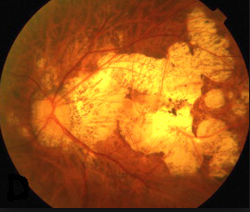
Imaginechina/Corbis
If you walk the streets of China today, you’ll quickly notice that most young people wear glasses. In Shanghai, for instance, 86 percent of high school students suffer from myopia, or nearsightedness, according to the government’s Xinhua News Agency.
Myopia has risen quickly in much of East Asia and Southeast Asia. And researchers are still trying to pin down exactly what’s driving the epidemic.
A study published Thursday offers one clue: Nearsightedness is nearly twice as common in one part of a middle-income province of China as it is in another part of a poorer province, researchers reported in the journal Ophthalmology.
Previous studies show myopia, in general, is linked to higher incomes, urbanization and education. Researchers, however, say it remains unclear how economic differences affect myopia
“I’m worried. Of course, I’m worried,” says a Shanghai mother named Wang, who has a 4-year-old daughter. The woman’s 10-year-old nephew already has myopia, and she’s afraid her daughter’s eyesight will follow suit.
Wang has her own theory about why myopia has risen so fast in the country.
“Sometimes when parents don’t have time to play with their children, they would throw a cellphone or an iPad to their kids to let them play,” she says. “Kids would become totally absorbed in the games. I think this is very damaging to their eyes.”
Although staring at screens can cause temporary problems, such as dry eyes and blurry vision, it’s still unknown if computers and iPads cause permanent eye issues, such as myopia.
Dr. He Mingguang, a Chinese ophthalmologist and leading myopia researcher, has another hypothesis.
“It’s the schooling system,” he says. Studies suggest China’s crushing homework load is putting too much strain on kids’ eyes, he says. A typical 10-year-old here eats supper on weeknights and then studies from 7 p.m. until 11:30 p.m. or midnight.
He, who’s now a research professor at the University of Melbourne, says changing habits in China is hard because the society is so competitive. School kids are forced to spend countless hours studying for the country’s do-or-die college entrance exam, the dreaded “gaokao.”
“A lot of Chinese parents, they think, if [their children] fail the university gaokao — or entry exam — they won’t have a good career,” He says.
Another study published in 2008, which focused on young, ethnic Chinese students in Singapore and Sydney, suggests more time outdoors in the sun might help.
Students surveyed in both countries spent similar amounts of time studying. But 29 percent of the Singaporean students had myopia compared with just 3 percent in Sydney.
“The big difference was the Chinese children in Australia were outdoors a lot more than their matched peers in Singapore,” says Ian Morgan, a retired biologist at Australian National University, who coauthored the 2008 study. “This was the only thing that fit with the huge difference in prevalence.”
Morgan thinks sunlight may stimulate the release of dopamine from the retina and inhibit the elongation of the eye that results in myopia.
Many Chinese children with myopia don’t wear glasses and just struggle with being nearsighted. It’s not because of the cost; a decent pair of glasses here costs just $5. It’s because some Chinese distrust spectacles.
“Parents, teachers and even some rural doctors think wearing glasses will harm kids’ eyes,” says Dr. Nathan Congdon, an ophthalmologist at Zhongshan Ophthalmic Center at Sun Yat-sen University in the southern city of Guangzhou, who led the new study. “In rural China, only about one-sixth of the kids who need glasses actually have them.”
Congdon has worked on studies in China that show glasses don’t weaken vision and actually improve academic performance. He hopes to use those data to change minds and persuade the government to provide more glasses to kids. That way, at least, they’ll be able to read a blackboard.
Why Myopia Progression Is a Concern
Are your child’s eyes getting worse year after year?
Some children who develop myopia (nearsightedness) have a continual progression of their myopia throughout the school years, including high school. And while the cost of annual eye exams and new glasses every year can be a financial strain for some families, the long-term risks associated with myopia progression can be even greater.
More Children Are Becoming Nearsighted
Myopia is one of the most common eye disorders in the world. The prevalence of myopia is about 30 to 40 percent among adults in Europe and the United States, and up to 80 percent or higher in the Asian population, especially in China.
And the incidence and prevalence of myopia are increasing. For example, in the early 1970s, only about 25 percent of Americans were nearsighted. But by 2004, myopia prevalence in the United States had grown to nearly 42 percent of the population.
Classification of Myopia Severity
Myopia — like all refractive errors — is measured in diopters (D), which are the same units used to measure the optical power of eyeglasses and contact lenses.
Lens powers that correct myopia are preceded by a minus sign (–), and are usually measured in 0.25 D increments.
The severity of nearsightedness is often categorized like this:
- Mild myopia: -0.25 to -3.00 D
- Moderate myopia: -3.25 to -6.00 D
- High myopia: greater than -6.00 D
Mild myopia typically does not increase a person’s risk for eye health problems. But moderate and high myopia sometimes are associated with serious, vision-threatening side effects. When this occurs in cases of high or very high myopia, the term degenerative myopia or pathological myopia sometimes is used.
Adults with high myopia usually started getting nearsighted when they were young children, and their myopia progressed year after year.

Myopia progression: When your child wears glasses to see the board in class and needs stronger glasses year after year.

Children who love to read may be at greater risk for myopia progression.
Myopia-Related Eye Problems
Here is a brief summary of significant eye problems that sometimes are associated with nearsightedness, particularly high myopia:
Myopia and cataracts. In a recent study of cataracts and cataract surgery outcomes among Koreans with high myopia, researchers found cataracts tended to develop sooner in highly myopic eyes compared with normal eyes.
And eyes with high myopia had a higher prevalence of coexisting disease and complications, such as retinal detachment.
Also, visual outcomes following cataract surgery were not as good among highly nearsighted eyes.
In an Australian study of more than 3,600 adults ages 49 to 97, the odds of having cataracts increased significantly with greater amounts of myopia.
Plus, the odds of having a particular type of cataract was twice as high among subjects with high myopia compared with those with low myopia.
Myopia and glaucoma. Myopia — even mild and moderate myopia — has been associated with an increased prevalence of glaucoma. In the same Australian study mentioned above, glaucoma was found in 4.2 percent of eyes with mild myopia and 4.4 percent of eyes with moderate-to-high myopia, compared with 1.5 percent of eyes without myopia.
The study authors concluded there is a strong relationship between myopia and glaucoma, and that nearsighted participants in the study had a two to three times greater risk of glaucoma than participants with no myopia.
Also, in a Chinese study, glaucoma was significantly associated with the severity of myopia. Among adults age 40 or older, those with high myopia had more than twice the odds of having glaucoma as study participants with moderate myopia, and more than three times the odds of having the disease compared with individuals with mild myopia.
Compared with participants who either had no myopia or were farsighted, those with high myopia had a 4.2 to 7.6 times greater odds of having glaucoma.

Myopia and retinal detachment. In a study published inAmerican Journal of Epidemiology, researchers found myopia was a clear risk factor for retinal detachment.
Results showed eyes with mild myopia had a four-fold increased risk of retinal detachment compared with non-myopic eyes. Among eyes with moderate and high myopia, the risk increased 10-fold.
The study authors also concluded that almost 55 percent of retinal detachments not caused by trauma are attributable to myopia.
In the Korean study mentioned above, among participants with high myopia due to elongated eye shape (axial myopia), the incidence of retinal detachment after cataract surgery was 1.72 percent, compared with 0.28 percent among participants with normal eye shape.
In a study conducted in the UK of the incidence of retinal detachment after cataract surgery, 2.4 percent of highly myopic eyes developed a detached retina within seven years following cataract extraction, compared with an incidence of 0.5 to 1 percent among eyes of any refractive error that underwent cataract surgery.
Myopia and refractive surgery. Also, many people with high myopia are not well-suited for LASIK or other laser refractive surgery. (Highly myopic individuals may still be good candidates for phakic IOL implantation or other vision correction procedures, however.)
What You Can Do About Myopia Progression
The best thing you can do to help slow the progression of your child’s myopia is to schedule annual eye exams so your eye doctor can monitor how much and how fast his or her eyes are changing.
Often, children with myopia don’t complain about their vision, so be sure to schedule annual exams even if they say their vision seems fine.
If your child’s eyes are changing rapidly or regularly, ask your eye doctor about ortho-k contact lenses or other myopia control measures to slow the progression of nearsightedness. 
References & Notes >>
[Page updated February 2016]
Why So Many Chinese Children Wear Glasses
Students in military uniforms balance bottles of water on their heads as they practice goose-stepping marching during a military training session at a college in Zhengzhou, Henan province September 17, 2014.REUTERS/Stringer
SPARKLY, spotted or Hello Kitty: every colour, theme, shape and size of frame is available at Eyeglass City in Beijing, a four-storey mall crammed only with spectacle shops.
Within half an hour a pair of prescription eyeglasses is ready. That is impressive, but then the number of Chinese wearing glasses is rising. Most new adoptees are children.
In 1970 fewer than a third of 16- to 18-year-olds were deemed to be short-sighted (meaning that distant objects are blurred). Now nearly four-fifths are, and even more in some urban areas. A fifth of these have “high” myopia, that is, anything beyond 16 centimetres (just over six inches) is unclear.
The fastest increase is among primary school children, over 40% of whom are short-sighted, double the rate in 2000. That compares with less than 10% of this age group in America or Germany.
The incidence of myopia is high across East Asia, afflicting 80-90% of urban 18-year-olds in Singapore, South Korea and Taiwan. The problem is social rather than genetic. A 2012 study of 15,000 children in the Beijing area found that poor sight was significantly associated with more time spent studying, reading or using electronic devices–along with less time spent outdoors.
These habits were more frequently found in higher-income families, says Guo Yin of Beijing Tongren Hospital, that is, those more likely to make their children study intensively. Across East Asia worsening eyesight has taken place alongside a rise in incomes and educational standards.
The biggest factor in short-sightedness is a lack of time spent outdoors. Exposure to daylight helps the retina to release a chemical that slows down an increase in the eye’s axial length, which is what most often causes myopia.
A combination of not being outdoors and doing lots of work focusing up close (like writing characters or reading) worsens the problem. But if a child has enough time in the open, they can study all they like and their eyesight should not suffer, says Ian Morgan of Australian National University.
Yet China and many other East Asian countries do not prize time outdoors. At the age of six, children in China and Australia have similar rates of myopia. Once they start school, Chinese children spend about an hour a day outside, compared with three or four hours for Australian ones.
Schoolchildren in China are often made to take a nap after lunch rather than play outside; they then go home to do far more homework than anywhere outside East Asia. The older children in China are, the more they stay indoors–and not because of the country’s notorious pollution.
Since poor sight is associated with higher incomes and more schooling, it is less prevalent in rural areas of China. In the countryside a third of primary-school students are myopic, compared with nearly half of urban children, according to the health ministry. But eyesight problems there are somewhat different. Stanford University’s Rural Education Action Programme found that one in six rural children with poor sight do not wear glasses–thanks to a combination of cost, poor eye care in schools and a mistaken belief that wearing glasses weakens eyes further.
When Stanford gave thousands of students free glasses, it found being able to see clearly had a higher impact on educational attainment than improving nutrition or the quality of teaching, says the programme’s co-director, Scott Rozelle. Another study reported that giving students free glasses improved test scores by the equivalent of nearly a year’s extra education.
Daylight and free glasses are both cheap remedies for a growing national problem. All that is required now is a bit of vision.
This study investigated the association of the 27 SNPs located in RASGRF1. GJD2, and ACTC1 genes with pathological myopia in a Chinese Han population.
Myopia patients were stratified according to whether they did (n = 274) or did not (n = 131) have myopic macular degeneration (MMD). The SNPbrowser software was used to identify specific SNPs for analysis and minimal allele frequency of >20%, and a pairwise r(2) < 0.85 were genotyped using MALDI-TOF mass spectrometry.
Before controlling for false discovery rate, the frequency of the rs1867315 C/C genotype compared with healthy controls was lower in the myopia group (p = 0.006) and in myopia patients without macular degeneration (p = 0.019). The frequency of the rs670957A/A genotype was also lower in patients without MMD compared with controls (p = 0.045). For rs2070664, the frequency of the A allele was higher in the patients with MMD compared to those without MMD (p = 0.032). After controlling for a false discovery rate of 5%, there was no significant difference in genotype and allele frequencies between these groups.
In this study, there was no association of the analyzed SNPs located in RASGRF1. GJD2, and ACTC1 with pathological myopia, suggesting that SNPs included in our study have no or a limited role in causing pathologic myopia in this Chinese Han population.
————
Genetic Links in Myopia
Ophthalmic Genet. 2015 Mar;36(1):1-7. doi: 10.3109/13816810.2013.812737. Epub 2013 Jul 8.
Evaluating the association between pathological myopia and SNPs in RASGRF1. ACTC1 and GJD2 genes at chromosome 15q14 and 15q25 in a Chinese population.
Abstract
BACKGROUND:
METHODS:
RESULTS:
CONCLUSION:
KEYWORDS:
Chinese; genotype;
A genome wide association study in European-derived populations identified several single nucleotide polymorphisms (SNPs) strongly associated with ocular refraction at 15q25 and 15q14.16,17 The associated SNPs in the region of 15q25 are near the RASGRF1 gene.16 RASGRF1 encodes a guanine nucleotide exchange factor and is highly expressed in the human retina. RASGRF1 is regulated by muscarinic receptors and retinoic acid which may provide biological mechanisms for refractive control.15,16 Two SNPs at chromosome 15q25, rs939658 and rs8027411, strongly associate with myopia in Dutch and British replication studies.16 For the 15q14 region, the most significant association signal was for a polymorphism (rs634990) located in a putative regulatory region near the GJD2 and ACTC1 genes.15,17 GJD2 encodes a neuron-specific protein (CONNEXIN 36) that is present in the retinal photoreceptors, amacrine and bipolar cells.15 ACTC1 which encodes cardiac muscle alpha actin is also expressed in the retina.17 Currently, it is not clear how these three genes may influence the development of myopia. However, the involvement of 15q14 and 15q25, was recently confirmed by a large scale multi-cohort international study that included Caucasians and Asians.18,19 A recent study in China also found alleles of rs634990 and rs524952 located on 15q14 showed evidence of allelic association with moderate to high myopia.20 This same study did not find significant association of the SNPs analyzed at 15q25 with high myopia,20 suggesting that other SNPs not yet investigated may influence the development of high myopia in Chinese populations.









 Like This Page? Please Share!
Like This Page? Please Share!







